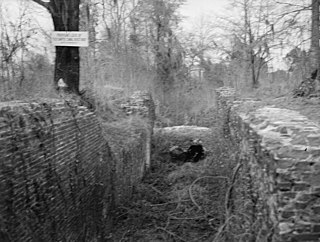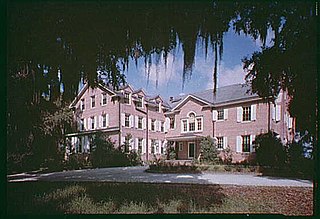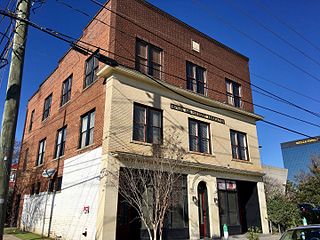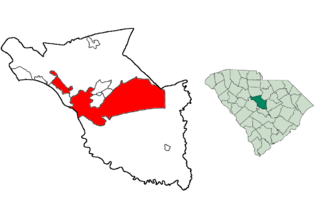
The Santee Canal was one of the earliest canals built in the United States. It was built to provide a direct water route between Charleston and Columbia, the new South Carolina state capital. It was named to the National Register of Historic Places in 1982.

The South Carolina Supreme Court is the highest court in the U.S. state of South Carolina. The court is composed of a Chief Justice and four Associate Justices.

The James Petigru Boyce Chapel is a historic church building at 1306 Hampton Street in Columbia, South Carolina. It is a Greek Revival building built in 1859. A convention met here on December 17, 1860, whose delegates voted unanimously for South Carolina to secede from the United States, leading to the American Civil War. It was designated a National Historic Landmark as First Baptist Church, the role it played at the time.

The Chappelle Administration Building, on the campus of Allen University in Columbia, South Carolina, was designed by John Anderson Lankford, known as the "dean of black architects." The building name has been spelled Chapelle Administration Building in HABS and NPS reports. It was declared a National Historic Landmark in 1976, cited as one Lankford's most important works.

The Clark Mills Studio is a historic building at 51 Broad Street in Charleston, South Carolina. Built as a tenement house, it was the residence and studio between 1837 and 1848 of sculptor Clark Mills (1810–83). Mills is credited with creating the first cast equestrian bronze statue, the 1852 statue of Andrew Jackson at Lafayette Square, Washington, D.C.. It was designated a National Historic Landmark in 1965, and now houses professional offices.

The Robert Mills House, also known as Robert Mills Historic House and Park or the Ainsley Hall House, is a historic house museum at 1616 Blanding Street in Columbia, South Carolina. Built in 1823 to a design by Robert Mills, it was designated a National Historic Landmark in 1973 for its architectural significance. The Historic Columbia Foundation owns and operates the home, which has been furnished with decorative arts of the early 19th century, including American Federal, English Regency, and French Empire pieces.

The Stuber–Stone Building is located at 4221–4229 Cass Avenue in Detroit, Michigan. It was listed on the National Register of Historic Places in 1996. It is now known as the Stuberstone Lofts.

The Lincoln American Tower is a 22-story building located at the corner of North Main and Court streets in Memphis, Tennessee. It is also a historical landmark, one of the first steel frame skyscrapers built in Memphis. The tower underwent a six-year refurbishing project starting in 2002, and despite a fire in 2006, is now open and accepting tenants.

Hobcaw Barony is a 16,000 acres (6,475 ha) tract on a peninsula called Waccamaw Neck between the Winyah Bay and the Atlantic Ocean in Georgetown County, South Carolina. Much of Hobcaw Barony is south of US Highway 17. The land was purchased by the investor, philanthropist, presidential advisor, and South Carolina native Bernard M. Baruch between 1905 and 1907 for a winter hunting retreat. Later, his eldest child, Belle W. Baruch, began purchasing the property from her father beginning in 1936. By 1956, Belle owned Hobcaw Barony entirely. Upon her death in 1964, the property was transferred to the Belle W. Baruch Foundation for a nature and research preserve. The property includes more than 37 historic buildings and structures representative of the eras of both 18th & 19th century rice cultivation and 20th century winter retreats. Hobcaw Barony was named to the National Register of Historic Places on November 2, 1994.

The House of Peace Synagogue is a former synagogue of the Beth Shalom Congregation in Columbia, South Carolina. It was originally located at 1318 Park Street. After the congregation moved in the 1935, the building was used for the Big Apple Club, which was an African-American night club. It was named to the National Register of Historic Places on August 28, 1979. In the early 1980s, the building was moved to its present location at the southeast corner of Hampton and Park Streets. In 1993, it was purchased by the Historic Columbia Foundation and is called the Big Apple.

The Missouri State Teachers Association Building is a historic building located at Columbia, Missouri. It was built in 1927 and houses the Missouri State Teachers Association Headquarters. The building is located on South 6th Street on the University of Missouri campus and is a two-story, Tudor Revival style brick building. It was the first building in the United States built specifically to house a state teachers association. A historical marker on the site commemorates the lands former tenant "Columbia College," the forerunner of the University of Missouri.

The B.B. Kirkland Seed and Distributing Company is a three-story historic warehouse building at 912 Lady Street in Columbia, South Carolina. It was listed on the National Register of Historic Places in 1979.

The Charles E. Simons Jr. Federal Court House is located in Aiken, South Carolina. It is significant for its association with the many federal construction programs of the Great Depression era. The building, designed by Columbia, South Carolina architects Lafaye and Lafaye, is an excellent example of a Georgian Revival building, a style often used during the 1920s and 1930s for government buildings in smaller towns. The Court House was listed in the National Register of Historic Places on December 10, 2003.

World War Memorial Building is a building designed by Lafaye & Lafaye in Columbia, South Carolina, United States.

New Brookland Historic District is a national historic district located at West Columbia, Lexington County, South Carolina. It encompasses 23 contributing buildings in the central business district and the "mill village" sections of West Columbia. It includes commercial, institutional, and residential buildings built between 1894 and 1916 as a planned residential community for the Columbia Duck Mill. Notable buildings include the Edward W. Shull Building, Thompson Funeral Home, Brookland Fire Station, Brookland Jail, and single and double tenant houses.

North Carolina Mutual Building, also known as the Blue Palace Tea Shop and Barber Shop, is a historic commercial building located at Columbia, South Carolina. It was built in 1909 by the North Carolina Mutual Life Insurance Company, and is a three-story, rectangular, brick commercial block. The building housed African-American businesses, professionals, and institutions during the years of Jim Crow segregation. It is located in the Washington Street business district, the city's black downtown.

Palmetto Compress and Warehouse Company Building is a historic cotton bale compress facility and warehouse building located at Columbia, South Carolina. The first section of the four-story brick building was built in 1917. The building was doubled in size in 1923.

The American Spinning Company Mill No. 2 is a historic mill complex at 300 Hammett Street, in a pocket of unincorporated Greenville County, South Carolina surrounded on three sides by the city of Greenville. It is a five-story brick building, to which a number of warehouse buildings and other additions were made. It was built in 1901-02, as part of a major expansion to the American Spinning Company's Mill No. 1, which originally stood just south of Hammett Street. It was built by Oscar Sampson, a Boston textile manufacturer to a design by the industrial design firm Lockwood and Greene, and is one of thirteen early 20th-century mills surviving in the Greenville area. It was listed on the National Register of Historic Places in 2016. Its major tenant now is the Victor Mill Company, a furniture maker.

The Carolina Life Insurance Company is a historic commercial building at 1501 Lady Street in Columbia, South Carolina, alternatively known as Seibels, Bruce & Company Building. It is a five-story masonry structure, finished primarily in limestone with granite trim. It presents an angled five-bay facade to the junction of Lady and Bull Streets, and is presently known as the Seibels Building. It was built in 1949 and enlarged in 1977; its original design by the local firm of Lafaye, Lafaye & Fair was a major contribution to the city's modern architecture. The Carolina Life Insurance Company only occupied the building until the early 1960s, when it was merged into another insurance company. It has since 1965 been home to Seibels, Bruce & Company, another insurer.

The Miller Brothers Cotton Warehouse is a historic cotton warehouse at 705 Gervais St. in Columbia, South Carolina. It is a low-profile single-story brick building, set at an angle to the street, in a city district historically occupied by many similar buildings. Built in 1872, its orientation is due to the presence of railroad tracks on either side of the parcel. Its first major owners were the Miller Brothers, dealers in cotton; it has been used to house foodstuffs and electrical equipment in its long history of use.




























